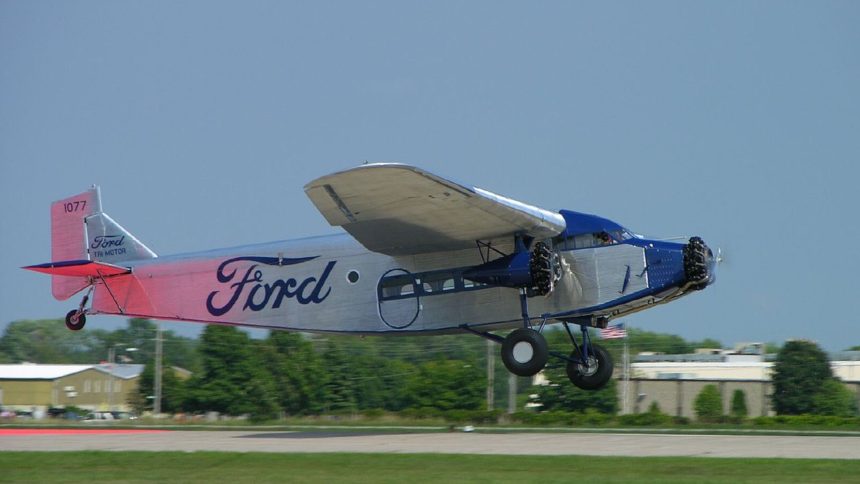Henry Ford claimed the all-metal, three-engine airliner was “the safest airliner around”, and it was rugged, simple, and reliable. Over one hundred airlines from all over the world flew Ford’s “Tin Goose”, and the aircraft also found its way into military service as well as executive transport duties and delivering cargo.
The Stout Metal Airplane Company
Henry Ford and other investors purchased the Stout Metal Airplane Company in 1925, run by William B. Stout, and the company became a division of Ford. Stout had produced a monoplane, the 2-AT (Air Transport), an all-metal, blended wing, corrugated metal skinned, single-engine design using the Liberty engine. The 2-AT was the first all-metal American certified aircraft. The aircraft was dubbed the “Tin Goose” by the news media at the time. It featured padded seats, opening windows, and even a bathroom. Only eleven were produced, with none surviving today.
With the resources of Ford now available, the three-engine redesign of the aircraft was accelerated, and the Stout 3-AT was produced. An unattractive aircraft with poor performance, it had two wing-mounted Wright J-4 radial engines and a third one located in the lower part of the nose. The aircraft was underpowered and had difficulty maintaining altitude. The plane performed so poorly that the test pilot refused to take it up again. Only one was built which was later destroyed in a fire at the factory.
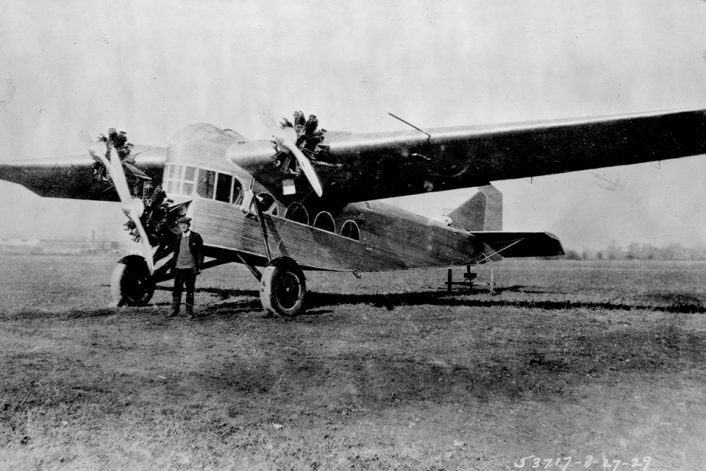
Disappointed by the failure of the 3-AT, Henry Ford had Stout removed from engineering, replacing him with Tom Towle, James McDonnell, who went on later to co-found McDonnell Douglas, John Lee and Otto Koppen. This team redesigned the 3-AT concept and created what would become the Ford Trimotor.
The 4-AT
First flying in 1926, and retaining the “Tin Goose” moniker of its predecessor, the Ford 4-AT had a crew of two to three: a pilot, co-pilot, and a flight attendant if a commercial airline flight. It carried eight passengers and was powered by three 200 horsepower Wright J-4 Whirlwind radial engines, with one mounted in the nose and the other two under each wing in strut braced nacelles. Control surfaces were also corrugated metal, and cables controlling the elevators and rudders were strung externally on the aircraft. Engine gauges were mounted externally just above the two wing-mounted power plants, allowing them to be read through the windows of the cockpit. Seventy-nine 4-AT aircraft were produced.
The corrugated metal skin increased the strength and ruggedness of the aircraft, but it also affected performance. Both speed and range were reduced by drag over using conventional aircraft skins. Corrugated skins had been used before by Junkers and the overall design of the 4-AT was very similar to Junkers designs and the Fokker F.VII. The similarities with the Junkers designs would cause legal problems for Ford.
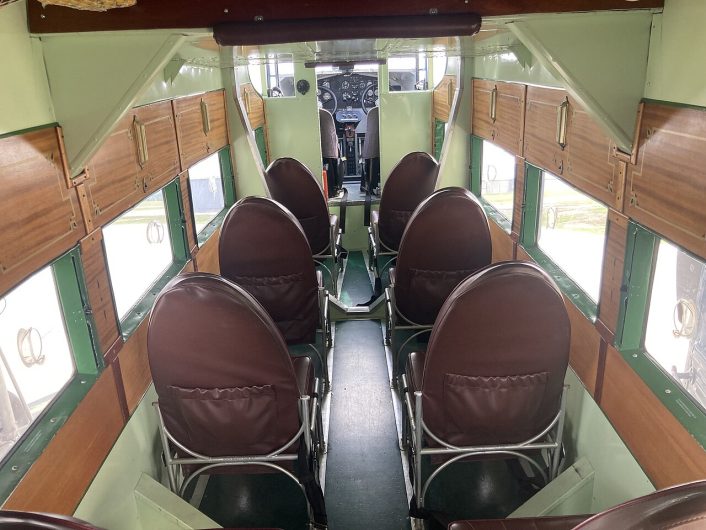
The 5-AT
The larger capacity 5-AT was introduced in 1928. Passenger capacity was increased to thirteen and up to seventeen in some variants, and wingspan was also increased. Engines were three Pratt & Whitney Wasp radials, each producing 420 horsepower. The top speed was around 150 mph; cruising speed was 122 mph with a range of 550 miles. The service ceiling was 18,500 ft. One unique feature of this aircraft was the luggage storage compartment located outside the engine in the wings. The doors to these compartments would open downward at an angle.
Total production of the 5-AT in different variants was 117 aircraft. One variant, the 5-AT-DS, was a floatplane version. There was also a Trimotor version with skis.
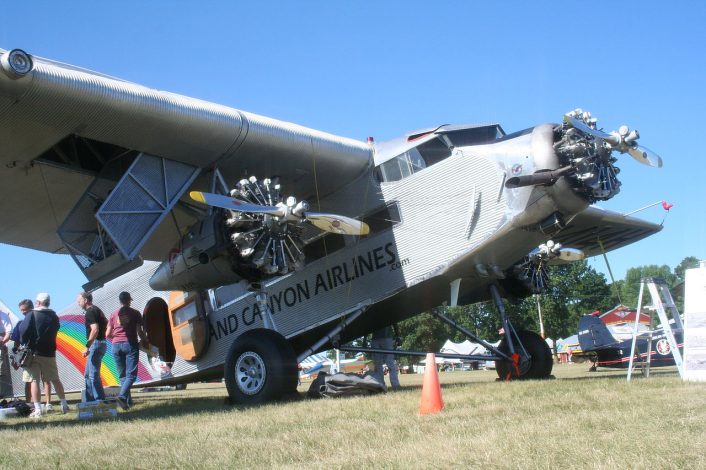
Military Service
While the Ford Trimotor was designed and built primarily as a commercial transport; the aircraft did see military service as well. The U.S. Army purchased a total of thirteen aircraft, the Navy and Marines purchased a total of nine. They served primarily as transports. One notable military use was during the Japanese invasion of the Philippines, a Trimotor was used at Bataan to evacuate people, cramming twenty four people inside the passenger compartment and flying five-hundred miles per trip, twice a day. The aircraft was destroyed on the ground by Japanese planes. Foreign militaries also flew Ford Trimotors, including Australia, Columbia, Spain, the United Kingdom, and Canada.
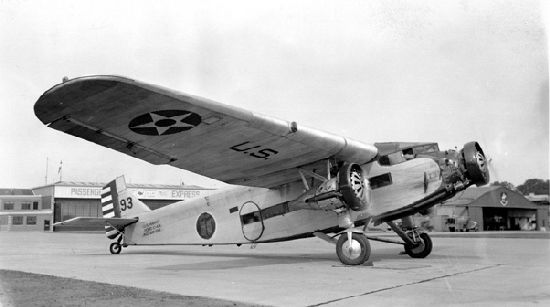
Significant Accomplishments and Flights
Pan American Airways flew Ford Trimotors, and in 1927 they scheduled their first international flights from Florida to Cuba. Other Central and South American destinations soon followed. Cuba, the Dominican Republic, Mexico, and Venezuela eventually had Trimotors being flown by airlines.
Richard Byrd made the first flight over the geographic South Pole in a Ford Trimotor November 27 and 28, 1929. Byrd had previously been flying Fokker Trimotors.
One aircraft, a 4-AT serial number 10, NC1077, has a distinctive history. Harry Brooks, Ford’s chief pilot, flew this aircraft. It was used to fly Charles Lindbergh’s mother to Mexico City to see her son. The aircraft is credited with the first flight from the U.S. to Mexico City. Both Amelia Earhart and Charles Lindbergh flew this particular aircraft. It also made the first commercial flight over the Canadian Rockies. The plane was damaged and left in the Yukon until it was salvaged in 1956, and in the 1980’s restoration began, being restored eventually to flying condition by Greg Herrick. NC1077 is the oldest Ford Trimotor in existence.
Franklin Roosevelt also flew on a Ford Trimotor during his presidential campaign in 1932, the days of the traditional train “whistle stops” were now over as aircraft soon took over the duties of transporting candidates on the campaign trail.
An early attempt at mid-air refueling was made using a Trimotor as a tanker in 1937, with a hose being tossed out the door of the stripped down Ford aircraft that was carrying makeshift fuel containers in the cabin, to a Lockheed Electra being flown by movie stunt flier Jimmie Mattern. The operation was a success, allowing the Electra to refuel and continue on in search of missing Soviet long-range pilot Sigizmund Levanevsky. The Trimotor, flown by another movie stunt flier, Garland Lincoln, later ran out of fuel and crashed however and was abandoned. Levanevsky was never found.
Transcontinental Air Transport (later TWA) provided a coast-to-coast traveling experience using Ford Trimotors coupled with rail service, linking New York and Los Angeles.
The Ford Trimotor in its day was the transport used by most airlines. It was rugged, reliable, and affordable. It was eventually surpassed by more advanced types in the 1930’s, relegating it to other duties which it performed very well. Trimotors went on to serve secondary airlines, corporate transport duties, and made excellent aircraft for suppling remote locations for mining companies. One even flew tours over the Grand Canyon up to 1991. They delivered the mail, carried freight, performed crop dusting, fought fires, island hopped, and even performed aerobatics. There is a handful still airworthy today and several reside in museums.


